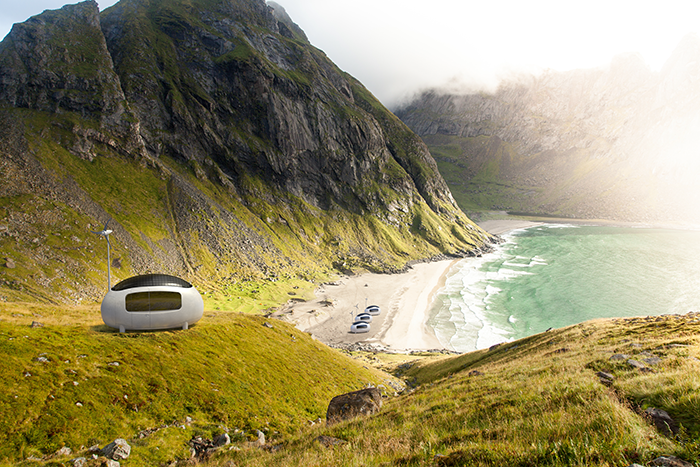Micro dwelling

|
| This micro dwelling is an Ecocapsule; a smart, self-sustainable micro-home that can be placed anywhere. |
Contents |
[edit] Introduction
Micro dwellings are single residential units that tend to range from 14 to 46 square metres. They can be built a foundations or other platforms or sometimes on wheels and typically have living quarters (kitchen, bathroom, sleeping accommodations), utilities (water, electricity, sewer connections) and are suitable for full time occupancy.
[edit] Background
Micro dwellings fall into a general category of residential living associated with the small house movement. They are referred to by different names, including micro apartments, micro homes, micro units, tiny homes, tiny houses and so on.
Restricted residential quarters have been in existence for centuries. In modern times, motorhomes were introduced in the early 1900s. Some people saw motorhomes as a way to travel with a greater degree of flexibility, as they had accommodation available anytime and anywhere.
In post-World War II America, new homes (such as those in the Levittown housing developments) were built to a modest scale with roughly 70 square metres of living space. However, that trend changed in the 1960s with the growth of the suburbs and migration away from the restrictions associated with city living.
In the 1970s, the modern small house movement emerged in contrast to suburban migration. It was seen as a permanent residential option that was particularly appealing to minimalist advocates who supported efforts to streamline lifestyles and improve housing affordability.
[edit] Growing popularity
The micro dwelling concept continued to gain popularity as an architectural and social movement in the 1990s for several reasons, including global economic instability, environmental concerns, increasing urban housing prices, lack of space and technological innovation. It has continued to gain momentum for people who are looking for affordable housing options due to financial limitations (such as living on a fixed income), personal hardship (such as homelessness) or other personal reasons (such as connecting with their families).
Maintaining a micro dwelling may also provide tax advantages while lowering utility bills and maintenance costs associated with traditional homes. This may be beneficial for people who lack the savings required for standard home upkeep costs.
[edit] International regulations
Unlike motorhomes, micro dwellings on wheels are permanent residences. Whether they are built on wheels or on foundations, they are meant to last as long as a traditional home and often use standard building techniques and materials.
In August 2017, the International Code Council (ICC) published its 2018 International Residential Code (IRC), which included Appendix Q Tiny Houses. This standard specifies various requirements (such as ceiling heights, stairways, lofts, emergency escape and so on) as they apply to single dwelling units that are 400 square feet (37 square metres) or less - excluding the loft space. This standard is applied in some US cities where micro dwellings are becoming increasingly popular.
[edit] Micro dwellings in the UK
UK micro dwellings are designed and built to comply with UK building regulations and planning permission requirements.
With wheel-based micro units, there are several additional considerations, particularly if the intention is to maintain their mobility features. Micro dwelling owners who wish to transport their homes must comply with UK caravan law restrictions regarding width, length and weight of the home. They may also wish to apply for a suitable driving licence if they plan to travel with the home frequently.
Some owners may wish to place their homes on land they already occupy, which may possible without planning permission under permitted development regulations as long as the micro dwelling is within a certain size and situation.
[edit] Related articles on Designing Buildings Wiki
- Affordable housing.
- Anchorhold.
- Building regulations.
- Could microhousing tackle London's housing crisis?
- Home ownership.
- Levittown.
- Megacity.
- Micro flats.
- Planning permission.
- Pocket homes.
- Smallest house in Britain.
- Suburb.
- Urban design.
[edit] External resources
Featured articles and news
Infrastructure that connect the physical and digital domains.
Harnessing robotics and AI in challenging environments
The key to nuclear decommissioning and fusion engineering.
BSRIA announces Lisa Ashworth as new CEO
Tasked with furthering BSRIA’s impressive growth ambitions.
Public buildings get half a million energy efficiency boost
£557 million to switch to cleaner heating and save on energy.
CIOB launches pre-election manifesto
Outlining potential future policies for the next government.
Grenfell Tower Inquiry announcement
Phase 2 hearings come to a close and the final report due in September.
Progress from Parts L, F and O: A whitepaper, one year on.
A replicated study to understand the opinion of practitioners.
ECA announces new president 2024
Electrical engineer and business leader Stuart Smith.
A distinct type of countryside that should be celebrated.
Should Part O be extended to existing buildings?
EAC brands heatwave adaptation a missed opportunity.
Definition of Statutory in workplace and facilities management
Established by IWFM, BESA, CIBSE and BSRIA.
Tackling the transition from traditional heating systems
59% lack the necessary information and confidence to switch.
The general election and the construction industry
As PM, Rishi Sunak announces July 4 date for an election.
Eco apprenticeships continue help grow green workforce
A year after being recognised at the King's coronation.
Permitted development rights for agricultural buildings
The changes coming into effect as of May 21, 2024.





















